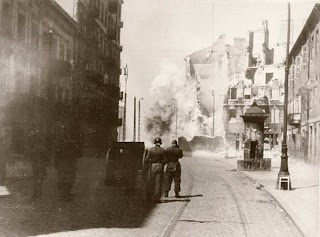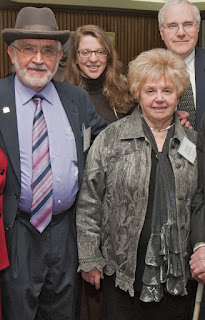Four years after the fall of Hitler, the tune would be used as a form of resistance against another 20th century tyrant. Paul Robeson traveled to Moscow in June 1949 to give a performance to an audience that included many Communist Party elites, as well as what little remained of the Jewish intelligentsia after Stalin's purges. At the end of the concert, Robeson stunned the audience with a surprise rendition of the Partisan Hymn. His introductory remarks contained references to the Yiddish language, the deep and enduring cultural ties between the US and Russian Jewish communities, as well as to leading Jewish intellectuals who had been "disappeared" by the regime.
The remarks, the spontaneous translation of the song to the shocked audience, and thunderous applause that followed were cut from the recording by Stalin's censors, but the chaos is evident in the mixture of applause and jeers that follow the actual performance. Lamentably, Robeson kept his criticisms of the Soviet Union to himself when he returned to the United States, not wishing to be used by right-wing political groups to advance their causes. But the recording remains, as does the pain and fury in Robeson's voice.
- Listen to the song performed by Betty Segal in Munich, 1946. (Yad Vashem archives)
- The Paul Robeson recording - Moscow, 1949. (Youtube)
- Traditional rendition by baritone singer Boris Kletinich
- Israeli musician Chava Alberstein's rendition, from the album Yiddish Songs (Youtube)
- The Partisan Hymn sung in the Capitol Rotunda during the 2010 Days of Remembrance ceremony (Youtube)
- A 2011 rendition by the Israeli heavy metal band Gevolt. (Youtube)
“Zog Nit Keynmol” Hymn of the Jewish Partisans
Zog nit keyn mol az du geyst dem letsten veg,
Khotsh himlen blayene farsthtelen bloye teg.
Never say you are walking your final road,
Though leaden skies conceal the days of blue.
Khotsh himlen blayene farsthtelen bloye teg.
Never say you are walking your final road,
Though leaden skies conceal the days of blue.
Kumen vet nokh undzer oysgebenkte sha'ah,
S'vet a poyk ton undzer trot mir zaynen do!
The hour that we have longed for will appear,
Our steps will beat out like drums: We are here!
S'vet a poyk ton undzer trot mir zaynen do!
The hour that we have longed for will appear,
Our steps will beat out like drums: We are here!
Fun grinem palmenland biz vaysen land fun shney,
Mir kumen on mit undzer payn, mit undzer vey.
From the green lands of palm trees to lands white with snow,
We are coming with all our pain and all our woe.
Mir kumen on mit undzer payn, mit undzer vey.
From the green lands of palm trees to lands white with snow,
We are coming with all our pain and all our woe.
Un vu gefalen s'iz a shpritz fun undzer blut,
Shprotzen vet dort undzer gevurah, undzer mut.
Wherever a spurt of our blood has fallen to the ground,
There our might and our courage will sprout again.
Shprotzen vet dort undzer gevurah, undzer mut.
Wherever a spurt of our blood has fallen to the ground,
There our might and our courage will sprout again.
S'vet di morgenzum bagilden undz dem haynt,
Un der nekhten vet farshvinden miten faynd.
The morning sun will shine on us one day,
Our enemy will vanish and fade away.
Un der nekhten vet farshvinden miten faynd.
The morning sun will shine on us one day,
Our enemy will vanish and fade away.
Nor oyb farzamen vet di zun in dem kayor,
Vi a parol zol geyn dos lid fun dor tsu dor.
But if the sun and dawn come too late for us,
From generation to generation let them be singing this song.
Vi a parol zol geyn dos lid fun dor tsu dor.
But if the sun and dawn come too late for us,
From generation to generation let them be singing this song.
Dos lid geshriben iz mit blut un nit mit blay,
S'iz nit keyn lidel fun a foygel oyf der fray,
This song is written in blood not in pencil-lead.
It is not sung by the free-flying birds overhead,
S'iz nit keyn lidel fun a foygel oyf der fray,
This song is written in blood not in pencil-lead.
It is not sung by the free-flying birds overhead,
Dos hot a folk tsvishen falendike vent,
Dos lid gezungen mit naganes in di hent!
But a people stood among collapsing walls,
And sang this song with pistols in their hands!
Dos lid gezungen mit naganes in di hent!
But a people stood among collapsing walls,
And sang this song with pistols in their hands!



 On October 7th,1944, at a line-up around three in the afternoon, a revolt in the Auschwitz concentration camp began with the swing of a hammer and a shout of “Hurrah!” from Chaim Neuhof, who had been a Sonderkommando – one of the prisoners selected to work in the gas chambers and crematoria – since 1942. The remaining Sonderkommando followed and assisted Neuhof in attacking the SS guards with hammers and axes that were smuggled in with the help of local partisans. An especially sadistic SS guard was thrown into the ovens after being stabbed - but still alive.
On October 7th,1944, at a line-up around three in the afternoon, a revolt in the Auschwitz concentration camp began with the swing of a hammer and a shout of “Hurrah!” from Chaim Neuhof, who had been a Sonderkommando – one of the prisoners selected to work in the gas chambers and crematoria – since 1942. The remaining Sonderkommando followed and assisted Neuhof in attacking the SS guards with hammers and axes that were smuggled in with the help of local partisans. An especially sadistic SS guard was thrown into the ovens after being stabbed - but still alive.
.jpg)












